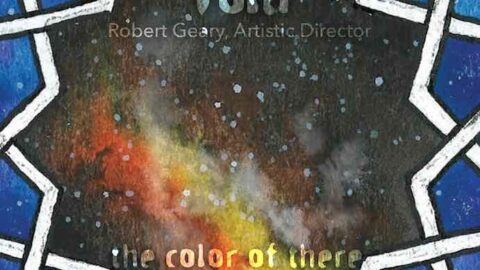Volti, a San-Francisco-based vocal ensemble led by Robert Geary, is passionately committed to commissioning and performing new vocal music. Their newest recording, the color of there seen from here (innova) is an impressive display of Volti’s enthusiastic approach to new works, facility in extended vocal techniques, and remarkable cohesiveness as an ensemble. This release features five works from as many composers: Forrest Pierce, Tonia Ko, Robin Estrada, Mark Winges, and Žibuoklè Martinaitytė. The disc is a success not only because of the wide variety of compositional voices, but also because of the sheer excellence of the ensemble.
the color of there seen from here opens with Gratitude Sutra (2013) by Forrest Pierce. Imbued with an eclectic education that includes Inayati Sufism, Hindustani classical music, and the Western Classical tradition, Pierce adeptly infuses his ode to gratitude (set to the text of a Mohawk prayer) with the repetition and chant-like declamation one might expect in to find in a sutra reading. Open, bright, and sustained unisons shift gracefully into dissonances, which open again into consonant harmonies, and then back to unisons, like gentle waves carrying the listener from one arrival point to another. The work expresses gratitude for a variety of elements–earth, plants, air, wild beings, water, sun, and sky–and Pierce is careful to honor the essence of each element by approaching them in different ways. Such reverence is captured in the flowing legato lines that praise water, the propulsive reflection on the wild beings, the expansive depiction of Mother Earth, bright, pulsing melodies for the sun, and murmurs for the “billions of stars” in the great sky. Often, the colors of the voices take precedence over intelligibility of the words themselves.

Tonia Ko was inspired by Virginia Woolf’s “ability to highlight the extraordinary and beautiful amidst a ‘normal’ setting…” and used the writer’s short story “Monday and Tuesday” as the foundation for From Ivory Depths. The first movement, “Monday,” opens dissonantly, voices rising and falling in volume, sliding from pitch to pitch. Fragments of declaimed text break through the sustained cushion of sound. Ko layers texture upon texture, expansive open vowels over the patter of crisp consonants, bringing each element out in turn. Ko notes, “The overall trajectory of the piece is that of fragmentation–a chorale, set in near slow-motion, progresses until it dissolves into muttered noises.” The contrasts provide a satisfying tension and release that continues throughout the piece–an engaging and well-crafted work.
We move into the sacred realm, while remaining firmly planted on earth, with Robin Estrada’s captivating Caeli enarrant. Drawing text from the Old and New Testaments (specifically, parts of Psalm 18 and Matthew 7:12), Estrada begins with a familiar “call to worship” of sorts, with a soloist calling out in prayer, and the ensemble answering in response. Caeli enarrant embraces the concept of “one vs. many.” When voices move homophonically, they are still often dissonant to each other, asserting their independence–each supplicant brings their own petitions to the mix, though the words are the same. As they come together and break apart, there is a sense of both animated dialogue and internal retreat.
All Night was composed in 2013 by Volti’s resident composer and advisor since 1990, Mark Winges. Its text is the sonically-driven poetry of Gustaf Sobin (1935-2000). Believing that the poems are “…so complete on their own,” Winges set out to “write music that mirrors/shows what the poems are and what the poems do, rather than what they say.” The result is an acoustically primordial and evocative soundscape.

Textual comprehensibility is not a concern in the final piece on the disc, Žibuoklė Martinaitytė’s The Blue of Distance, as singers explore the vast timbral, dynamic, and range possibilities of the voice on vowels alone. Around 3.5 minutes from the end of the 13-minute work, the piece intensifies with grand swells of voices overlapping on bright exclamations of “Ah!” crescendoing and pulling away, slowing falling silent.
Volti’s claim that “attending [one of their concerts] is like visiting a contemporary art gallery, stimulating the mind, the imagination, and the heart” certainly rings true for this album. Each work complements the others and each composer’s voice can be heard clearly and appreciated on its own merit. the color of there seen from here is an intriguing presentation of some of the most cutting-edge contemporary choral music being written today, and Robert Geary and his singers should be commended for their impeccable musicianship and artistry.
























